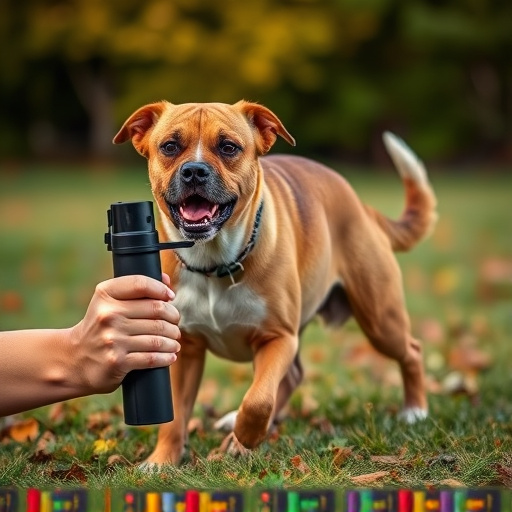Dog deterrent spray, featuring capsaicin as its active ingredient, is a powerful tool for dog defense at ranges of 3-15 feet (1-4 meters). Contrary to popular belief, studies show its effectiveness can extend up to 20 feet (6 meters) under optimal conditions. For maximum impact, aim for the dog's face and eyes. Effective defense drills require training in handling, deployment, and understanding environmental factors, along with safety measures like ventilation and decontamination instructions.
“Uncover the power of dog deterrent spray in effective pepper spray dog defense drills. Understanding its mechanism and dispelling common myths about its range is key to harnessing this tool’s potential. This article navigates the science behind the spray, separating fact from fiction regarding its reach. Additionally, it explores essential training and safety considerations for those looking to incorporate this method into their personal or professional security strategies, ensuring responsible and effective use.”
- Understanding Dog Deterrent Spray: How It Works
- Effective Range: Fact vs. Fiction
- Training and Safety Considerations for Pepper Spray Defense Drills
Understanding Dog Deterrent Spray: How It Works
Dog deterrent spray, also known as pepper spray for dogs, is a powerful tool in effective dog defense drills. It works by targeting the canine’s sensory system, specifically the eyes and nose, causing temporary disorientation and discomfort. The active ingredient, capsaicin, mimics the chemical found in chili peppers, stimulating nerve endings and triggering a burning sensation. This sudden irritant disrupts a dog’s normal behavior patterns, making it an effective deterrent for various scenarios.
When used properly, dog deterrent spray can create a safe distance between the user and the dog, allowing for controlled interactions or escape. The range of effectiveness varies based on factors like the product quality, environmental conditions, and the dog’s size and sensitivity. High-quality sprays with a stronger concentration can deter dogs from up to 10-15 feet (3-4 meters), while lesser concentrations may only be effective up to 3-5 feet (1-1.5 meters). Understanding these ranges is crucial in choosing the right defense drill for different situations, ensuring maximum safety and minimal impact on non-target species.
Effective Range: Fact vs. Fiction
The effectiveness of dog deterrent spray, often in the form of pepper spray, is a topic shrouded in misconception. Many believe its reach is limited to mere feet, but the reality is far more intricate. The ‘effective range’ isn’t a fixed distance; it varies based on several factors such as wind speed and direction, atmospheric conditions, and the concentration of the spray. Studies suggest that effective pepper spray dog defense drills can be successful up to 20 feet (6 meters) in optimal conditions.
However, this range isn’t a strict boundary. In practice, the spray’s impact diminishes with distance, becoming less potent beyond 10 feet (3 meters). Proper usage involves understanding these dynamics and employing techniques that maximize the spray’s reach and effectiveness. This includes aiming towards the dog’s face and eyes, which are particularly sensitive areas, and ensuring a steady stream or multiple pulses to disrupt and deter aggressive behavior.
Training and Safety Considerations for Pepper Spray Defense Drills
When implementing effective pepper spray dog defense drills, training and safety should be at the forefront of your preparation. It’s crucial to teach individuals how to responsibly handle and deploy the spray, focusing on technique and minimizing off-target effects. Drills should emphasize proper application, considering factors like wind direction and proximity to other people or pets. Safety measures include ensuring adequate ventilation during practice sessions and providing clear instructions on decontamination procedures after use.
Additionally, regular mock scenarios can help participants become familiar with the spray’s effective range and its impact. Training should cover both theoretical knowledge of the spray’s chemical composition and practical skills in deployment. Emphasizing safe handling and responsible usage fosters an environment where individuals are prepared to defend themselves effectively while mitigating potential risks associated with pepper spray use.
Dog deterrent spray, also known as pepper spray, has been hailed as an effective tool for personal protection against aggressive dogs. However, understanding its actual effective range is crucial for implementing successful dog defense drills. While popular belief may exaggerate its reach, proper usage and training can make it a valuable addition to your safety arsenal. By incorporating effective pepper spray dog defense drills into your routine, you can gain confidence and peace of mind when encountering potentially dangerous canine encounters.
